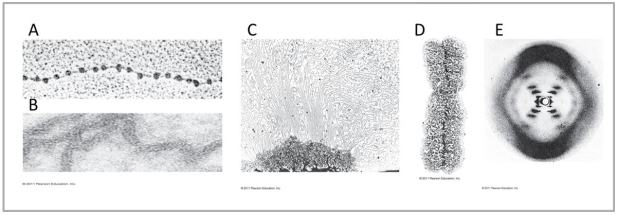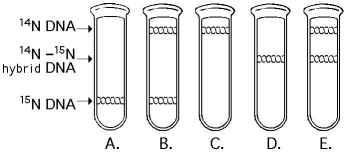A) With an RNA virus radioactive protein would have been in the final pellet.
B) With an RNA virus radioactive RNA would have been in the final pellet.
C) With an RNA virus the liquid portion would have been radioactive.
D) With an RNA virus the protein shell would have been radioactive in both samples.
E) It is not possible to predict the results.
Correct Answer

verified
Correct Answer
verified
Multiple Choice
Which of the enzymes synthesizes short segments of RNA?
A) helicase
B) topoisomerase
C) single-stranded binding protein
D) DNA polymerase I
E) primase
Correct Answer

verified
Correct Answer
verified
Multiple Choice
The experiments that led to the discovery of Okazaki fragments gave evidence for which of the following ideas?
A) DNA polymerase is a directional enzyme that synthesizes leading and lagging strands during replication.
B) DNA is a polymer consisting of four monomers: adenine, thymine, guanine, and cytosine.
C) DNA is the genetic material.
D) Bacterial replication is fundamentally different from eukaryotic replication.
E) Replication occurs in the 3' to 5' direction.
Correct Answer

verified
Correct Answer
verified
Multiple Choice
Cytosine makes up 42% of the nucleotides in a sample of DNA from an organism.Approximately what percentage of the nucleotides in this sample will be thymine?
A) 8%
B) 16%
C) 31%
D) 42%
E) It cannot be determined from the information provided.
Correct Answer

verified
Correct Answer
verified
Multiple Choice
Which of the enzymes covalently connects segments of DNA?
A) helicase
B) topoisomerase
C) DNA ligase
D) single-stranded binding protein
E) primase
Correct Answer

verified
Correct Answer
verified
Multiple Choice
To repair a thymine dimer by nucleotide excision repair,in which order do the necessary enzymes act?
A) exonuclease, DNA polymerase III, RNA primase
B) helicase, DNA polymerase I, DNA ligase
C) DNA ligase, nuclease, helicase
D) DNA polymerase I, DNA polymerase III, DNA ligase
E) endonuclease, DNA polymerase I, DNA ligase
Correct Answer

verified
Correct Answer
verified
Multiple Choice
 The images above are of DNA at various levels of coiling and folding.Use this image to answer the questions below.
-Which image represents the 10 nm fibre,showing nucleosomes?
The images above are of DNA at various levels of coiling and folding.Use this image to answer the questions below.
-Which image represents the 10 nm fibre,showing nucleosomes?
A) A
B) B
C) C
D) D
E) E
Correct Answer

verified
Correct Answer
verified
Multiple Choice
These calculations follow what rule?
A) the rule of diminishing returns
B) Chargaff's rule
C) Mendel's law
D) the 5' - 3' rule
E) the rule of linkage
Correct Answer

verified
Correct Answer
verified
Multiple Choice
Which of the following statements describes the eukaryotic chromosome?
A) It is composed of DNA alone.
B) The nucleosome is its most basic functional subunit.
C) The number of genes on each chromosome is different in different cell types of an organism.
D) It consists of a single linear molecule of double-stranded DNA plus proteins.
E) Active transcription occurs on heterochromatin but not euchromatin.
Correct Answer

verified
Correct Answer
verified
Multiple Choice
 The images above are of DNA at various levels of coiling and folding.Use this image to answer the questions below.
-Which image represents the chromatid?
The images above are of DNA at various levels of coiling and folding.Use this image to answer the questions below.
-Which image represents the chromatid?
A) A
B) B
C) C
D) D
E) E
Correct Answer

verified
Correct Answer
verified
Multiple Choice
What is the difference between the leading strand and the lagging strand in DNA replication?
A) The leading strand is synthesized in the 3' → 5' direction in a discontinuous fashion, while the lagging strand is synthesized in the 5'→ 3' direction in a continuous fashion.
B) The leading strand is synthesized continuously in the 5'→ 3' direction, while the lagging strand is synthesized discontinuously in the 5'→ 3' direction.
C) The leading strand requires an RNA primer, whereas the lagging strand does not.
D) There are different DNA polymerases involved in elongation of the leading strand and the lagging strand.
E) The leading strand is synthesized in the 3' → 5' direction in a continuous fashion, while the lagging strand is synthesized in the 5'→ 3' direction in a discontinuous fashion.
Correct Answer

verified
Correct Answer
verified
Multiple Choice
If a cell were unable to produce histone proteins,which of the following would be a likely effect?
A) There would be an increase in the amount of "satellite" DNA produced during centrifugation.
B) The cell's DNA couldn't be packed into its nucleus.
C) Spindle fibres would not form during prophase.
D) Amplification of other genes would compensate for the lack of histones.
E) Pseudogenes would be transcribed to compensate for the decreased protein in the cell.
Correct Answer

verified
Correct Answer
verified
Multiple Choice
At a specific area of a chromosome,the sequence of nucleotides below is present where the chain opens to form a replication fork: 3' C C T A G G C T G C A A T C C 5' An RNA primer is formed starting at the underlined T (T) of the template.Which of the following represents the primer sequence?
A) 5' G C C T A G G 3'
B) 3' G C C T A G G 5'
C) 5' A C G T T A G G 3'
D) 5' A C G U U A G G 3'
E) 5' G C C U A G G 3'
Correct Answer

verified
Correct Answer
verified
Multiple Choice
Who performed classic experiments that supported the semiconservative model of DNA replication?
A) Watson and Crick
B) Meselson and Stahl
C) Hershey and Chase
D) Franklin and Wilkins
E) Avery
Correct Answer

verified
Correct Answer
verified
Multiple Choice
What catalyzes the formation of phosphodiester bonds between adjacent nucleotides in the DNA polymer being formed?
A) ribozymes
B) DNA polymerase
C) ATP
D) deoxyribonucleotide triphosphates
E) helicase
Correct Answer

verified
Correct Answer
verified
Multiple Choice
Use the following figure to answer the questions below.
 -Once the pattern found after one round of replication was observed,Meselson and Stahl could be confident of which of the following conclusions?
-Once the pattern found after one round of replication was observed,Meselson and Stahl could be confident of which of the following conclusions?
A) Replication is semi-conservative.
B) Replication is not dispersive.
C) Replication is not semi-conservative.
D) Replication is not conservative.
E) Replication is neither dispersive nor conservative.
Correct Answer

verified
Correct Answer
verified
Multiple Choice
An Okazaki fragment has which of the following arrangements?
A) primase, polymerase, ligase
B) 3' RNA nucleotides, DNA nucleotides 5'
C) 5' RNA nucleotides, DNA nucleotides 3'
D) DNA polymerase I, DNA polymerase III
E) 5' DNA to 3'
Correct Answer

verified
Correct Answer
verified
Multiple Choice
In his transformation experiments,what did Griffith observe?
A) Mutant mice were resistant to bacterial infections.
B) Mixing a heat-killed pathogenic strain of bacteria with a living nonpathogenic strain can convert some of the living cells into the pathogenic form.
C) Mixing a heat-killed nonpathogenic strain of bacteria with a living pathogenic strain makes the pathogenic strain nonpathogenic.
D) Infecting mice with nonpathogenic strains of bacteria makes them resistant to pathogenic strains.
E) Mice infected with a pathogenic strain of bacteria can spread the infection to other mice.
Correct Answer

verified
Correct Answer
verified
Multiple Choice
Which of the following can be determined directly from X-ray diffraction photographs of crystallized DNA?
A) the diameter of the helix
B) the rate of replication
C) the sequence of nucleotides
D) the bond angles of the subunits
E) the frequency of A vs. T nucleotides
Correct Answer

verified
Correct Answer
verified
Multiple Choice
Individuals with the disorder xeroderma pigmentosum are hypersensitive to sunlight.This occurs because their cells are impaired in what way?
A) They cannot replicate DNA.
B) They cannot undergo mitosis.
C) They cannot exchange DNA with other cells.
D) They cannot repair thymine dimers.
E) They do not recombine homologous chromosomes during meiosis.
Correct Answer

verified
Correct Answer
verified
Showing 41 - 60 of 84
Related Exams